seats Hyundai Santa Fe 2019 - RHD (UK, Australia) User Guide
[x] Cancel search | Manufacturer: HYUNDAI, Model Year: 2019, Model line: Santa Fe, Model: Hyundai Santa Fe 2019Pages: 682, PDF Size: 16.24 MB
Page 39 of 682
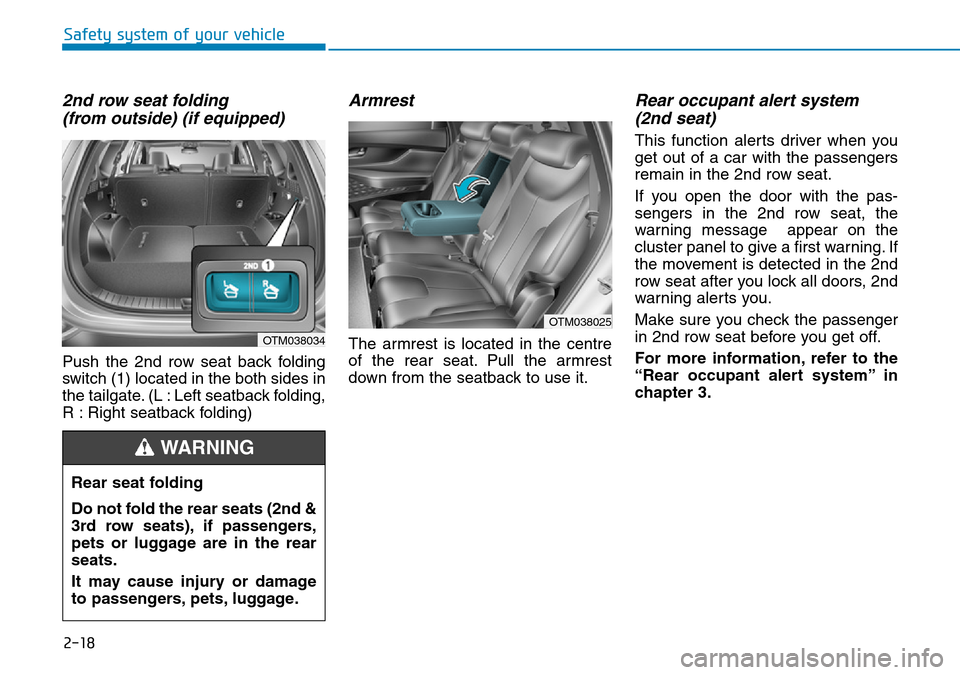
2-18
Safety system of your vehicle
2nd row seat folding
(from outside) (if equipped)
Push the 2nd row seat back folding
switch (1) located in the both sides in
the tailgate. (L : Left seatback folding,
R : Right seatback folding)
Armrest
The armrest is located in the centre
of the rear seat. Pull the armrest
down from the seatback to use it.
Rear occupant alert system
(2nd seat)
This function alerts driver when you
get out of a car with the passengers
remain in the 2nd row seat.
If you open the door with the pas-
sengers in the 2nd row seat, the
warning message appear on the
cluster panel to give a first warning. If
the movement is detected in the 2nd
row seat after you lock all doors, 2nd
warning alerts you.
Make sure you check the passenger
in 2nd row seat before you get off.
For more information, refer to the
“Rear occupant alert system” in
chapter 3.
OTM038034
OTM038025
Rear seat folding
Do not fold the rear seats (2nd &
3rd row seats), if passengers,
pets or luggage are in the rear
seats.
It may cause injury or damage
to passengers, pets, luggage.
WARNING
Page 40 of 682
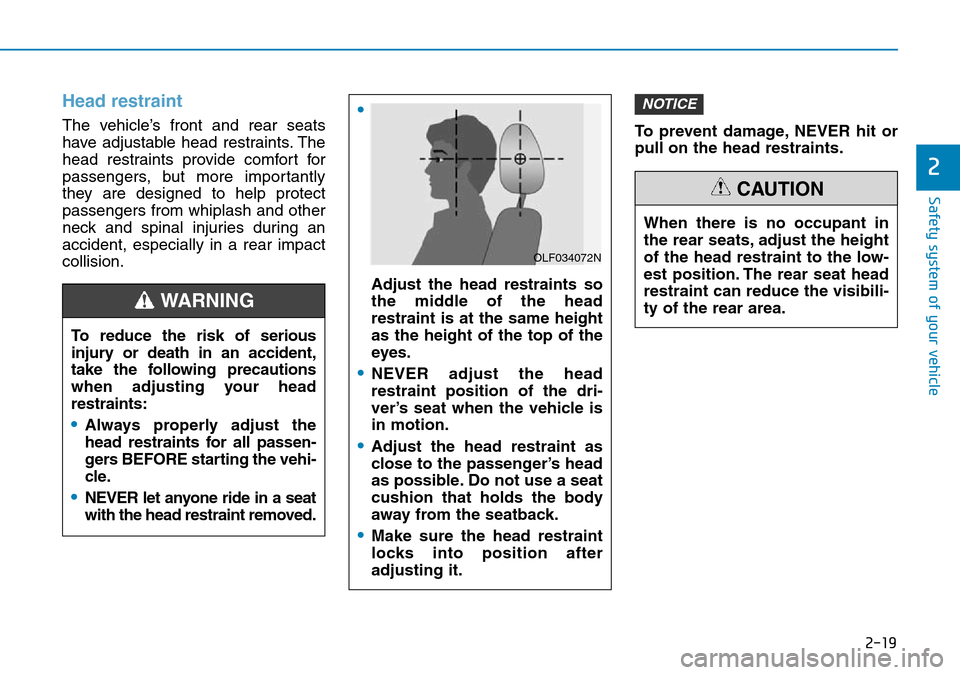
2-19
Safety system of your vehicle
2
Head restraint
The vehicle’s front and rear seats
have adjustable head restraints. The
head restraints provide comfort for
passengers, but more importantly
they are designed to help protect
passengers from whiplash and other
neck and spinal injuries during an
accident, especially in a rear impact
collision.To prevent damage, NEVER hit or
pull on the head restraints.
NOTICE
To reduce the risk of serious
injury or death in an accident,
take the following precautions
when adjusting your head
restraints:
•Always properly adjust the
head restraints for all passen-
gers BEFORE starting the vehi-
cle.
•NEVER let anyone ride in a seat
with the head restraint removed.
•
Adjust the head restraints so
the middle of the head
restraint is at the same height
as the height of the top of the
eyes.
•NEVER adjust the head
restraint position of the dri-
ver’s seat when the vehicle is
in motion.
•Adjust the head restraint as
close to the passenger’s head
as possible. Do not use a seat
cushion that holds the body
away from the seatback.
•Make sure the head restraint
locks into position after
adjusting it.
WARNING
OLF034072N
When there is no occupant in
the rear seats, adjust the height
of the head restraint to the low-
est position. The rear seat head
restraint can reduce the visibili-
ty of the rear area.
CAUTION
Page 41 of 682
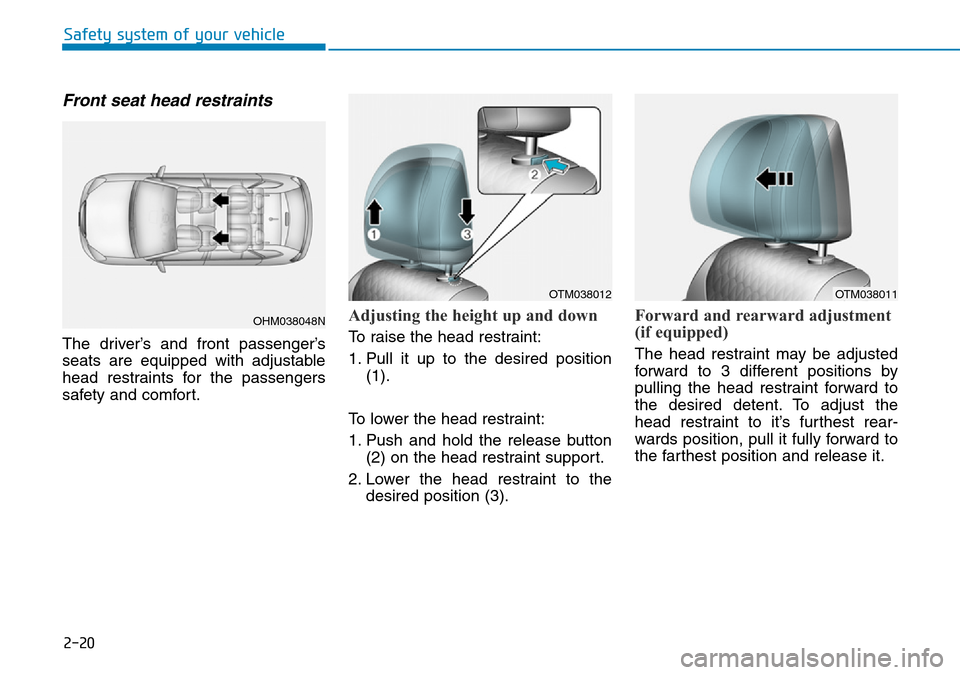
2-20
Safety system of your vehicle
Front seat head restraints
The driver’s and front passenger’s
seats are equipped with adjustable
head restraints for the passengers
safety and comfort.
Adjusting the height up and down
To raise the head restraint:
1. Pull it up to the desired position
(1).
To lower the head restraint:
1. Push and hold the release button
(2) on the head restraint support.
2. Lower the head restraint to the
desired position (3).
Forward and rearward adjustment
(if equipped)
The head restraint may be adjusted
forward to 3 different positions by
pulling the head restraint forward to
the desired detent. To adjust the
head restraint to it’s furthest rear-
wards position, pull it fully forward to
the farthest position and release it.
OHM038048N
OTM038012OTM038011
Page 43 of 682
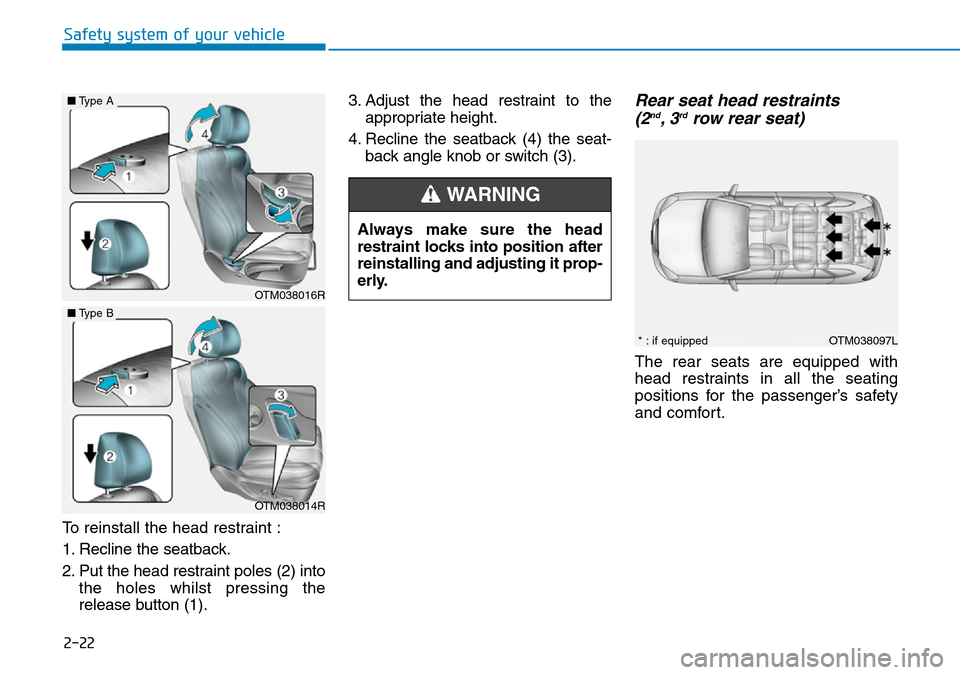
2-22
Safety system of your vehicle
To reinstall the head restraint :
1. Recline the seatback.
2. Put the head restraint poles (2) into
the holes whilst pressing the
release button (1).3. Adjust the head restraint to the
appropriate height.
4. Recline the seatback (4) the seat-
back angle knob or switch (3).
Rear seat head restraints
(2nd,3rdrow rear seat)
The rear seats are equipped with
head restraints in all the seating
positions for the passenger’s safety
and comfort.
OTM038097L* : if equipped
Always make sure the head
restraint locks into position after
reinstalling and adjusting it prop-
erly.
WARNING
OTM038016R
OTM038014R
■Type A
■Type B
Page 45 of 682
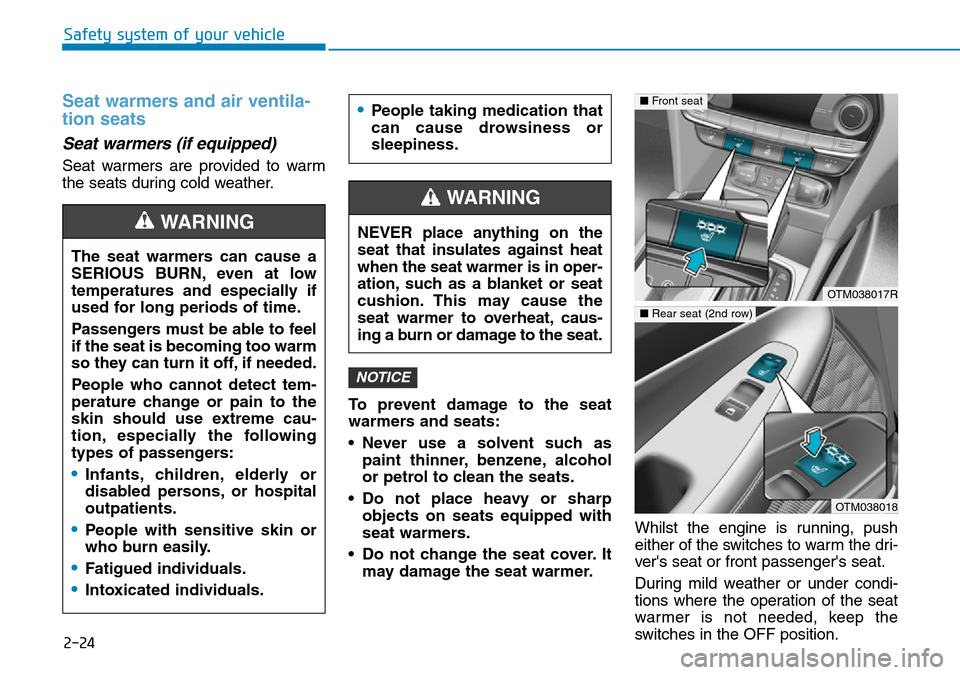
2-24
Safety system of your vehicle
Seat warmers and air ventila-
tion seats
Seat warmers (if equipped)
Seat warmers are provided to warm
the seats during cold weather.
To prevent damage to the seat
warmers and seats:
• Never use a solvent such as
paint thinner, benzene, alcohol
or petrol to clean the seats.
• Do not place heavy or sharp
objects on seats equipped with
seat warmers.
• Do not change the seat cover. It
may damage the seat warmer.Whilst the engine is running, push
either of the switches to warm the dri-
ver's seat or front passenger's seat.
During mild weather or under condi-
tions where the operation of the seat
warmer is not needed, keep the
switches in the OFF position.
NOTICE
The seat warmers can cause a
SERIOUS BURN, even at low
temperatures and especially if
used for long periods of time.
Passengers must be able to feel
if the seat is becoming too warm
so they can turn it off, if needed.
People who cannot detect tem-
perature change or pain to the
skin should use extreme cau-
tion, especially the following
types of passengers:
•Infants, children, elderly or
disabled persons, or hospital
outpatients.
•People with sensitive skin or
who burn easily.
•Fatigued individuals.
•Intoxicated individuals.
WARNING
•People taking medication that
can cause drowsiness or
sleepiness.
NEVER place anything on the
seat that insulates against heat
when the seat warmer is in oper-
ation, such as a blanket or seat
cushion. This may cause the
seat warmer to overheat, caus-
ing a burn or damage to the seat.
WARNING
OTM038017R
OTM038018
■Front seat
■Rear seat (2nd row)
Page 46 of 682
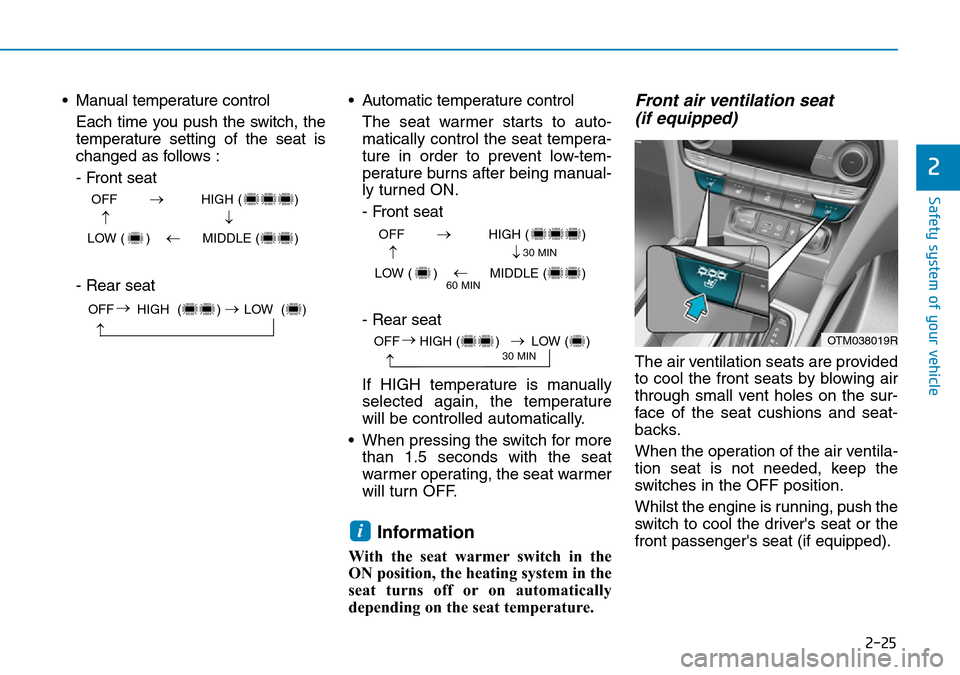
2-25
Safety system of your vehicle
2
• Manual temperature control
Each time you push the switch, the
temperature setting of the seat is
changed as follows :
- Front seat
- Rear seat• Automatic temperature control
The seat warmer starts to auto-
matically control the seat tempera-
ture in order to prevent low-tem-
perature burns after being manual-
ly turned ON.
- Front seat
- Rear seat
If HIGH temperature is manually
selected again, the temperature
will be controlled automatically.
• When pressing the switch for more
than 1.5 seconds with the seat
warmer operating, the seat warmer
will turn OFF.
Information
With the seat warmer switch in the
ON position, the heating system in the
seat turns off or on automatically
depending on the seat temperature.
Front air ventilation seat
(if equipped)
The air ventilation seats are provided
to cool the front seats by blowing air
through small vent holes on the sur-
face of the seat cushions and seat-
backs.
When the operation of the air ventila-
tion seat is not needed, keep the
switches in the OFF position.
Whilst the engine is running, push the
switch to cool the driver's seat or the
front passenger's seat (if equipped).
i
OFF HIGH ( )
LOW ( ) MIDDLE ( )
→→
→
→
OFF HIGH ( )
LOW ( ) MIDDLE ( )
→→
→
→
30 MIN
60 MIN
OFF HIGH ( ) LOW ( )
→
→
→
OTM038019R30 MINOFF HIGH ( ) LOW ( )→
→
→
Page 47 of 682
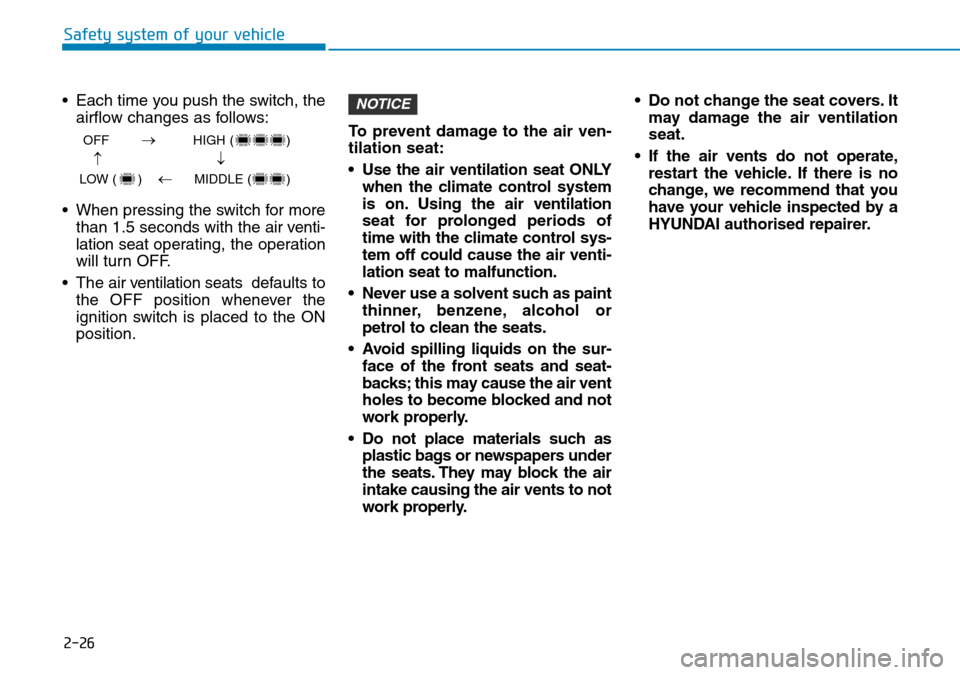
2-26
Safety system of your vehicle
• Each time you push the switch, the
airflow changes as follows:
• When pressing the switch for more
than 1.5 seconds with the air venti-
lation seat operating, the operation
will turn OFF.
• The air ventilation seats defaults to
the OFF position whenever the
ignition switch is placed to the ON
position.To prevent damage to the air ven-
tilation seat:
• Use the air ventilation seat ONLY
when the climate control system
is on. Using the air ventilation
seat for prolonged periods of
time with the climate control sys-
tem off could cause the air venti-
lation seat to malfunction.
• Never use a solvent such as paint
thinner, benzene, alcohol or
petrol to clean the seats.
• Avoid spilling liquids on the sur-
face of the front seats and seat-
backs; this may cause the air vent
holes to become blocked and not
work properly.
• Do not place materials such as
plastic bags or newspapers under
the seats. They may block the air
intake causing the air vents to not
work properly.• Do not change the seat covers. It
may damage the air ventilation
seat.
• If the air vents do not operate,
restart the vehicle. If there is no
change, we recommend that you
have your vehicle inspected by a
HYUNDAI authorised repairer.
NOTICE
OFF HIGH ( )
LOW ( ) MIDDLE ( )
→→
→
→
Page 48 of 682
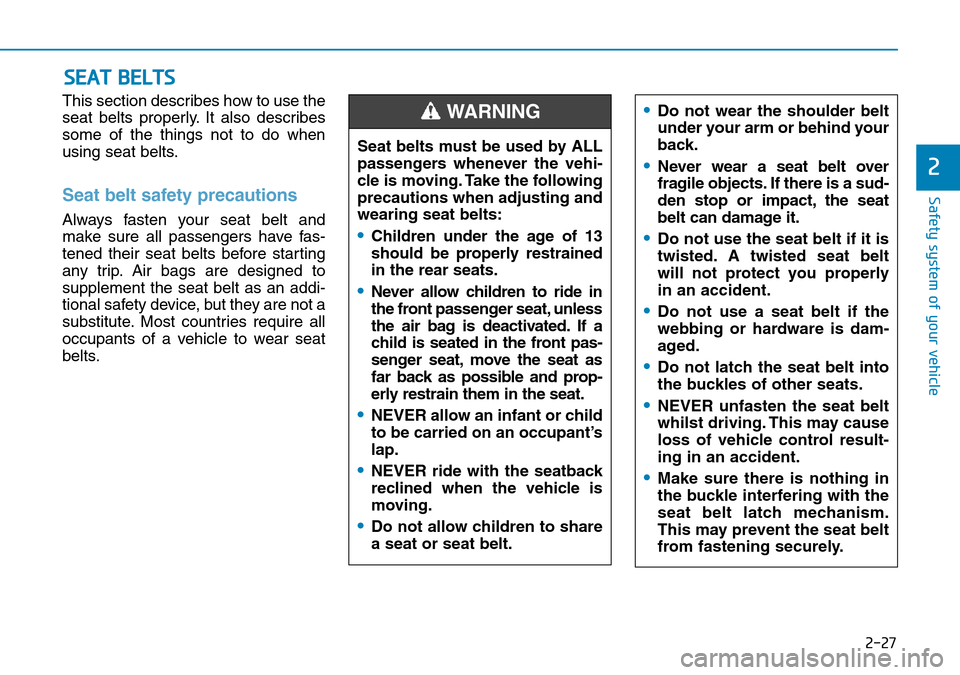
2-27
Safety system of your vehicle
2
This section describes how to use the
seat belts properly. It also describes
some of the things not to do when
using seat belts.
Seat belt safety precautions
Always fasten your seat belt and
make sure all passengers have fas-
tened their seat belts before starting
any trip. Air bags are designed to
supplement the seat belt as an addi-
tional safety device, but they are not a
substitute. Most countries require all
occupants of a vehicle to wear seat
belts.
SEAT BELTS
Seat belts must be used by ALL
passengers whenever the vehi-
cle is moving. Take the following
precautions when adjusting and
wearing seat belts:
•Children under the age of 13
should be properly restrained
in the rear seats.
•Never allow children to ride in
the front passenger seat, unless
the air bag is deactivated. If a
child is seated in the front pas-
senger seat, move the seat as
far back as possible and prop-
erly restrain them in the seat.
•NEVER allow an infant or child
to be carried on an occupant’s
lap.
•NEVER ride with the seatback
reclined when the vehicle is
moving.
•Do not allow children to share
a seat or seat belt.
WARNING •Do not wear the shoulder belt
under your arm or behind your
back.
•Never wear a seat belt over
fragile objects. If there is a sud-
den stop or impact, the seat
belt can damage it.
•Do not use the seat belt if it is
twisted. A twisted seat belt
will not protect you properly
in an accident.
•Do not use a seat belt if the
webbing or hardware is dam-
aged.
•Do not latch the seat belt into
the buckles of other seats.
•NEVER unfasten the seat belt
whilst driving. This may cause
loss of vehicle control result-
ing in an accident.
•Make sure there is nothing in
the buckle interfering with the
seat belt latch mechanism.
This may prevent the seat belt
from fastening securely.
Page 55 of 682
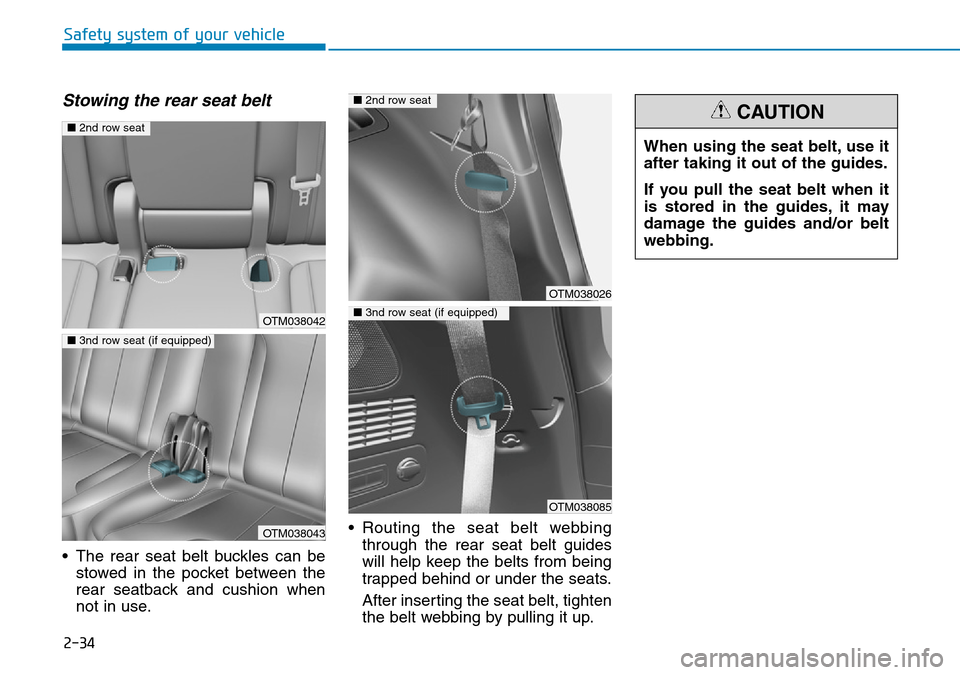
2-34
Safety system of your vehicle
Stowing the rear seat belt
• The rear seat belt buckles can be
stowed in the pocket between the
rear seatback and cushion when
not in use.• Routing the seat belt webbing
through the rear seat belt guides
will help keep the belts from being
trapped behind or under the seats.
After inserting the seat belt, tighten
the belt webbing by pulling it up.
OTM038042
OTM038043
■2nd row seat
■3nd row seat (if equipped)
OTM038026
OTM038085
■2nd row seat
■3nd row seat (if equipped)
When using the seat belt, use it
after taking it out of the guides.
If you pull the seat belt when it
is stored in the guides, it may
damage the guides and/or belt
webbing.
CAUTION
Page 58 of 682
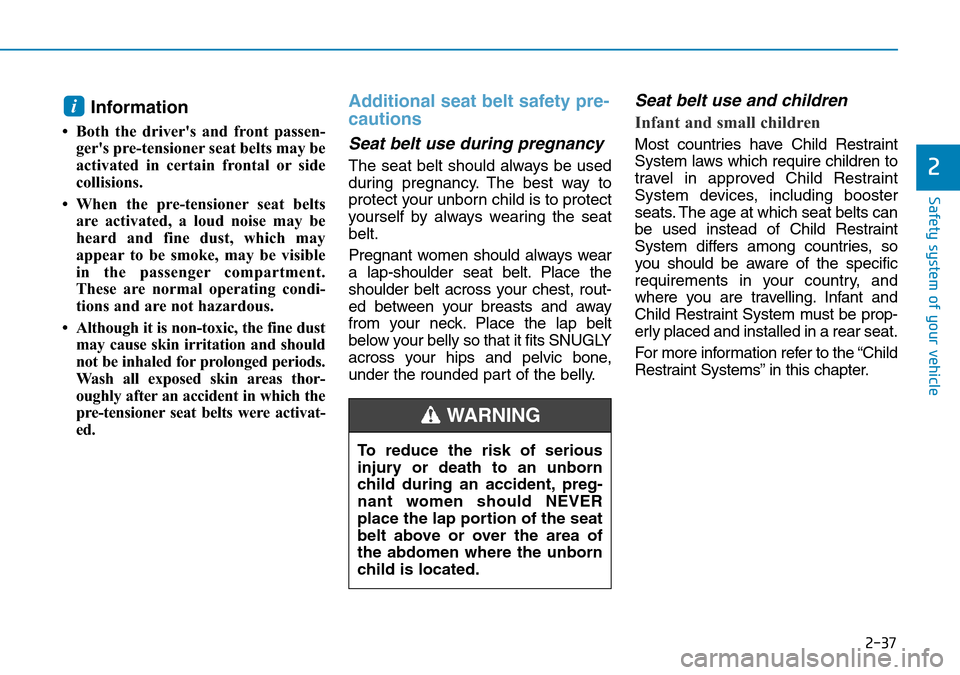
2-37
Safety system of your vehicle
2
Information
• Both the driver's and front passen-
ger's pre-tensioner seat belts may be
activated in certain frontal or side
collisions.
• When the pre-tensioner seat belts
are activated, a loud noise may be
heard and fine dust, which may
appear to be smoke, may be visible
in the passenger compartment.
These are normal operating condi-
tions and are not hazardous.
• Although it is non-toxic, the fine dust
may cause skin irritation and should
not be inhaled for prolonged periods.
Wash all exposed skin areas thor-
oughly after an accident in which the
pre-tensioner seat belts were activat-
ed.
Additional seat belt safety pre-
cautions
Seat belt use during pregnancy
The seat belt should always be used
during pregnancy. The best way to
protect your unborn child is to protect
yourself by always wearing the seat
belt.
Pregnant women should always wear
a lap-shoulder seat belt. Place the
shoulder belt across your chest, rout-
ed between your breasts and away
from your neck. Place the lap belt
below your belly so that it fits SNUGLY
across your hips and pelvic bone,
under the rounded part of the belly.
Seat belt use and children
Infant and small children
Most countries have Child Restraint
System laws which require children to
travel in approved Child Restraint
System devices, including booster
seats. The age at which seat belts can
be used instead of Child Restraint
System differs among countries, so
you should be aware of the specific
requirements in your country, and
where you are travelling. Infant and
Child Restraint System must be prop-
erly placed and installed in a rear seat.
For more information refer to the “Child
Restraint Systems” in this chapter.
i
To reduce the risk of serious
injury or death to an unborn
child during an accident, preg-
nant women should NEVER
place the lap portion of the seat
belt above or over the area of
the abdomen where the unborn
child is located.
WARNING